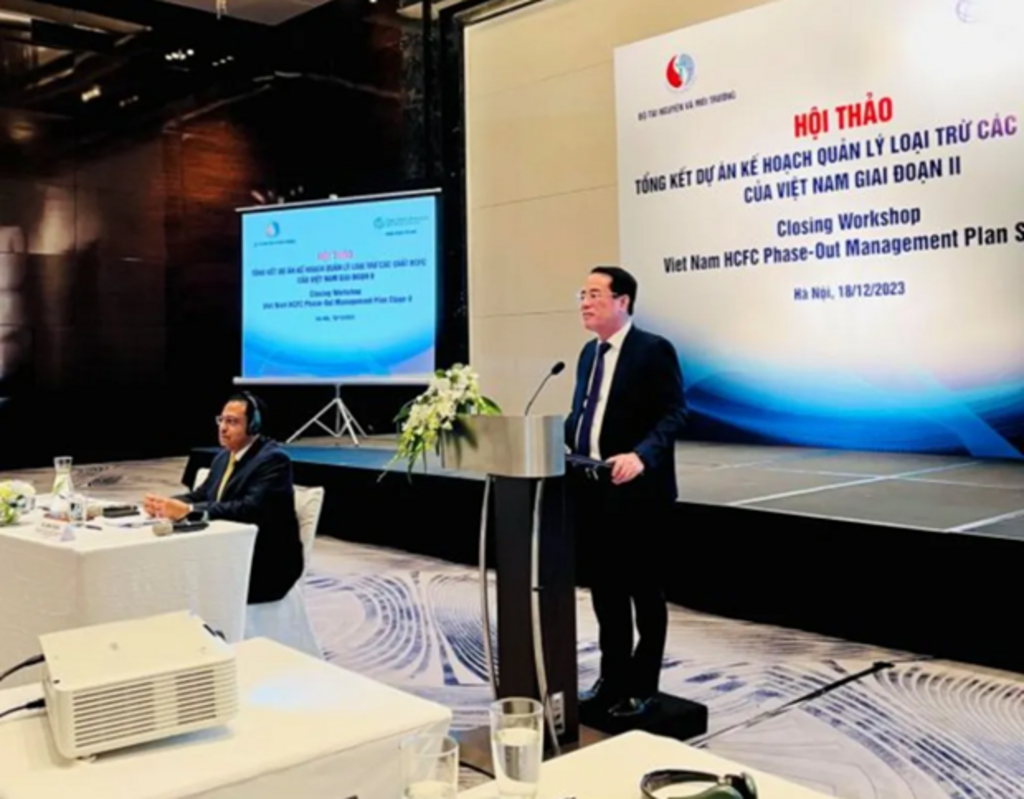 |
| Tang The Cuong, Director of the Department of Climate Change speaks at a workshop held in Hanoi on December 18__Photo: VNS/VNA |
The second phase of Vietnam's HCFC Phase-out Management Project has achieved many positive results, contributing to the protection of the ozone layer and helping the country fulfill its committed goals following the Vienna Convention and the Montreal Protocol.
The project’s five-year second phase was approved by the Minister of Natural Resources and Environment in June 2018, said Tang The Cuong, director of the Department of Climate Change under the Ministry of Natural Resources and Environment at a workshop held in Hanoi on December 18.
The ministry is the national focal point implementing the Montreal Protocol on substances that deplete the ozone layer and the agency implementing the project.
Ozone depleting substances include chlorofluorocarbons (CFCs), hydrochlorofluorocarbons (HCFCs), halons, methyl bromide, carbon tetrachloride, hydrobromofluorocarbons, chlorobromomethane, and methyl chloroform.
The implementation of the project was funded by the Multilateral Fund for the Implementation of the Montreal Protocol and the World Bank was entrusted to manage the implementation of the project.
According to Cuong, the ministry has coordinated with the World Bank to carry out the project’s second phase between 2018 and 2023 in order to comply with the obligation to eliminate 35 percent of consumption of HCFCs following the Montreal Protocol.
So far, the country had cut down the consumption of 1,000 tons of HCFC-22 in household air conditioning production, refrigeration equipment manufacturing and refrigeration equipment maintenance service.
The country supported its only air conditioner manufacturing enterprise and a number of refrigeration equipment manufacturing enterprises to convert production technology that does not use R-22 gas - a powerful greenhouse gas. It had banned the import of air conditioners using R-22 gas since January 7, 2022.
It has also completely eliminated consumption of HCFC-141b, contained in pre-blended polyol systems, in foam insulation production as well as supporting foam-production businesses to convert to technology. It had banned the import of HCFC-141b contained in pre-blended polyol systems since January 7, 2023.
Additionally, the country ensured the completion of reducing 35 percent of HCFC consumption in the period of 2020-24.
Vietnam's annual consumption report for the period of 2020-24 showed that the import level of HCFCs was less than 2,600 tons per year so far, meeting requirements under the Montreal Protocol.
Cuong also said that Vietnam had reduced greenhouse gas emissions by using alternative technologies that had no ozone depletion potential and low global warming potential.
The country strengthened controlling import and export of HCFCs and raise awareness about protecting the ozone layer and protecting the environment, he said.
In term of training and capacity building, the project trained 350 customs officers on export and import management of controlled substances; 188 teachers of vocational education institutions and more than 3,200 technicians on leak management and good practice principles in installation, maintenance and repair of refrigeration and air conditioning.
The project also provided 110 sets of teaching equipment and 300 sets of repair equipment for vocational education establishments, repair and maintenance service establishments of refrigeration and air conditioning across the country.
“The results are gained thanks to the active support of World Bank experts, close coordination of relevant ministries, sectors and agencies,” Cuong said.
He also added that the results were achieved especially thanks to the efforts and determination of businesses participating in technology transformation that had overcome the difficulties of the COVID-19 pandemic and practical situation to promptly deploy activities.
Speaking at the workshop, Ahmed Eiweida, World Bank’s Vietnam Sector Leader for Sustainable Development, said the project’s second phase had made a significant progress in eliminating many substances that depleted the ozone layer.
“The project has successfully reduced HCFC consumption by 1,000 tons, contributing to the protection of ozone layer and climate change mitigation,” he said.
Vietnam ratified the Montreal Protocol on Substances that Deplete the Ozone Layer in 1994.
In 2001, Vietnam had completely eliminated the use of Chlorofluorocarbons (CFCs), Halon, and Carbon tetrachloride (CCL4).
In 2012, the country launched a plan to support foam manufacturing enterprises to phase down pure HCFC-14b substance, aiming to reduce 10 percent of the total consumption of the substance in the country.
In 2018, it launched another plan to support enterprises with technology transformation to phase down ozone-depleting substances, aiming to reduce 35 percent of the consumption of these substances.
In 2019, Vietnam ratified the Kigali Amendment. The Kigali Amendment to the Montreal Protocol is an international agreement to gradually reduce the consumption and production of HFCs.
Cuong said the Montreal Protocol had proven to be an effective tool in protecting human health, nature and climate on a global scale over the past decades.
The Department of Climate Change would continue coordinating with the World Bank, the United Nations Environment Program (UNEP) and international organizations to consult the Government and the environment ministry to deploy measures to protect the ozone layer as well as the fulfillment of the Montreal Protocol, including the Kigali Amendment in the future, he said.
He believed that lessons learned from the implementation of the project’s second phase along with effective coordination between stakeholders would help to successfully implement the Montreal Protocol, contributing to healing the hole in the ozone layer, and responding to climate change.
According to the UNEP, the Montreal Protocol on Substances that Deplete the Ozone Layer is the landmark multilateral environmental agreement that regulates the production and consumption of nearly 100 man-made chemicals referred to as ozone depleting substances (ODS).
When released into the atmosphere, those chemicals damage the stratospheric ozone layer, Earth’s protective shield that protects humans and the environment from harmful levels of ultraviolet radiation from the sun. Adopted on 16 September 1987, the Protocol is to date one of the rare treaties to achieve universal ratification.- (VNA/VLLF)









